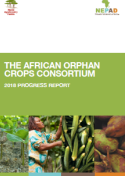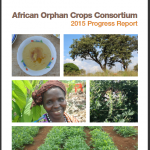 2018 was a significant year for the African Orphan Crops Consortium (AOCC). This year, the AOCC and the United Nations Food and Agriculture Organization (FAO) mobilized to improve nutritional security in all FAO member states, as detailed in their letter of intent agreed in 2017. This represents a crucial milestone, as the agreement and initiatives recognize and promote the AOCC’s ‘orphan crops’ approach to addressing food security by improving the nutritional content of key crop species in Africa.
2018 was a significant year for the African Orphan Crops Consortium (AOCC). This year, the AOCC and the United Nations Food and Agriculture Organization (FAO) mobilized to improve nutritional security in all FAO member states, as detailed in their letter of intent agreed in 2017. This represents a crucial milestone, as the agreement and initiatives recognize and promote the AOCC’s ‘orphan crops’ approach to addressing food security by improving the nutritional content of key crop species in Africa.
 Providing nutritious food and assuring food security for a growing world population is one of the key development challenges of our day. In sub-Saharan Africa, the challenges are particularly acute; some 233 million people are hungry and/or undernourished, according to a 2016 report by the UN Food and Agriculture Organization. Chronic undernourishment affects approximately 30% of the population. That level of hunger is one of the highest in the world. While the reasons for this are complex, they include widespread poverty, poor infrastructure and communications, diseases such as malaria and HIV and civil strife. As a result, the nourishment of a large percentage of African families is dependent principally on what they can grow themselves or buy locally.
Providing nutritious food and assuring food security for a growing world population is one of the key development challenges of our day. In sub-Saharan Africa, the challenges are particularly acute; some 233 million people are hungry and/or undernourished, according to a 2016 report by the UN Food and Agriculture Organization. Chronic undernourishment affects approximately 30% of the population. That level of hunger is one of the highest in the world. While the reasons for this are complex, they include widespread poverty, poor infrastructure and communications, diseases such as malaria and HIV and civil strife. As a result, the nourishment of a large percentage of African families is dependent principally on what they can grow themselves or buy locally.

The goal of the African Orphan Crops Consortium (AOCC) is to make the nutritious indigenous plants that are raised in the home gardens of Africa or that grow in the fields, forests and common lands of the continent even more nutritious than they already are — as well as more productive and resilient. The aim is to improve the diets and livelihoods of the 600 million people who live in rural SubSaharan Africa. Led by the New Partnership for Africa’s Development (NEPAD), the technical body of the African Union (AU), the young Consortium, founded in 2011, has already achieved great success. It has graduated its first class of African plant-breeding scientists and technicians. It has begun sequencing the genomes of crops on its list of 101 important species. It also has raised significant funding and created an uncommon collaboration of governments, companies, NGOs and scientific bodies to help it reach its goals…. here